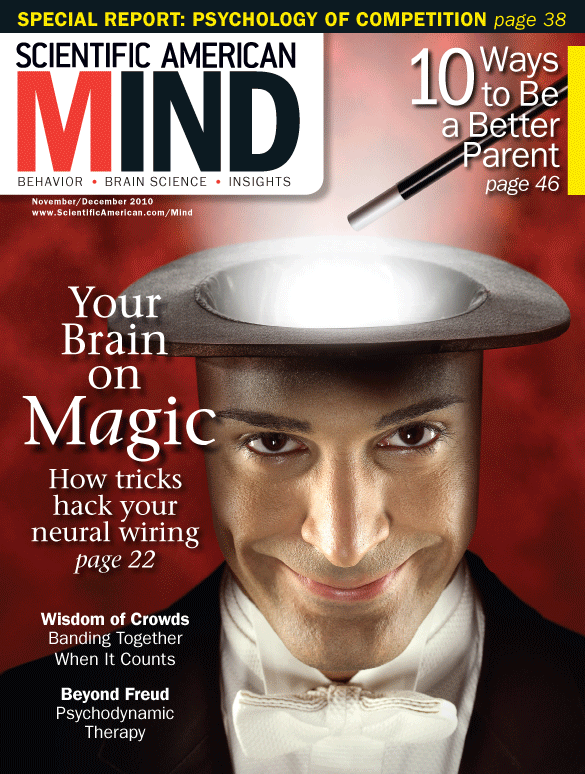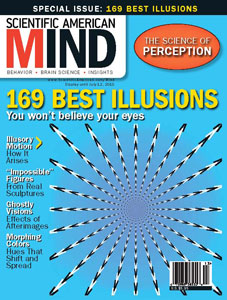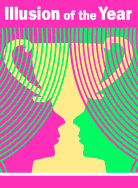Think that your eyes are bigger than your stomach? Well, actually, yes… they are.
The Portion Size Illusion is a new variant of an old classic illusion called the Ebbinghaus illusion, in which a circle surrounded by smaller circles looks bigger than the same circle surrounded by bigger circles. It shows that, to your visual system, everything is relative.
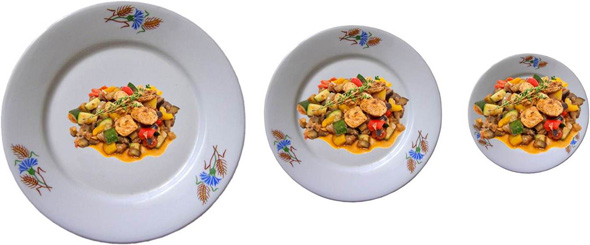
http://www.moillusions.com/2012/09/the-portion-size-optical-illusion.html
In the new foodie-friendly recipe, your brain is fricasseed, and your mind is served up on a platter, when the same serving of food appears in different sizes by virtue of the relative size of the plate. Use this illusion at home to make yourself feel like you’re eating like a pig, when in reality you’re just using a smaller bucket.
— Stephen Macknik
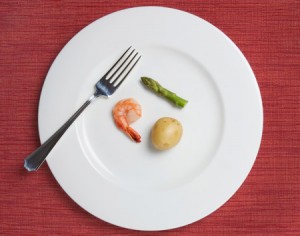
http://www.google.com/search?q=small+food+portion+image&ie=UTF-8&oe=UTF-8&hl=en&client=safari#miuv=1
“The only way to keep your health is to eat what you don’t want, drink what you don’t like, and do what you’d rather not.” – Mark Train
Twain may have been correct about health, but longevity may be another matter altogether. Eat, drink, and be merry… if you want to die: that is what the evidence has shown for the last 75 years, right? In a way, perhaps it was too good to be true: go on a diet and live happily ever after… forever. Well, not forever, but, yes, for significantly longer. It still seems to be a robust finding in mice and rats, where lifetimes are short and easily measured in the lifetime of a single grant funding cycle. But a new careful, well-controlled, and decade-spanning study from a group at the National Institute on Aging has shown that, whereas monkeys that are put on a restricted diet long-term may be healthier than monkeys that are fed 50% more, they don’t live longer. But you have to admit that they during monkeys do look spritely.
— Stephen Macknik

http://www.nature.com.ezproxy1.lib.asu.edu/nature/journal/vaop/ncurrent/pdf/nature11484.pdf
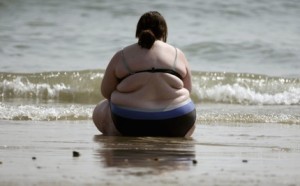
http://www.theatlantic.com/daily-dish/archive/2007/05/fat-and-prejudice/228603/
I just want to thank you all for being so even-minded and fair when it comes to your attitudes about fat people. Or are you? According to a landmark study by Brian Nosek and his colleagues working with the inventors of the Implicit Association Test (IAT), Anthony Greenwald and Mahzarin Banaji, you actually probably aren’t. So I take back my thanks, you bigot.
The IAT is a wonderful tool to assess implicit associations between two concepts (like fat and thin) and two attributes (like good and bad). The experimenter displays, for example, a picture of a fat person and the word “bad” and the observer’s job is to simply press a keyboard button, as fast as possible. Images may be sorted according to four categories (thin/good, thin/bad, fat/good, or fat/bad). When you see 40 trials of these examples (10 for each association), what you find is that people tend to answer more quickly for concepts that are associated well with the attribute (i.e. fat/bad and thin/good) whereas they slow down in responding to concepts that are mismatched to the attributes (i.e. fat/good and thin/bad). This happens even if the observer self-reports as unbiased, or even if the observer has the attribute discriminated against (in this case, implicit association bias affect even people who are obese). What’s especially interesting about weight attitudes is that the bias works against ingroup matches. An outgroup is a social group that you consider to be different to you (i.e. fat people are an outgroup if you consider yourself thin). In most IAT tests of attitudes observers have positive attitudes towards their ingroup members. For example, Americans tend to see other Americans as part of the same ingroup and reflect on them positively, whereas foreigners are seen as members of an outgroup and produce longer delays in response in the IAT. But the study shows both fat and thin people (69%) preferred thin people over fat people on the IAT (only 12% of respondents liked the fatties).
So this suggests that if you are fat, there is likely bias working against you, from the people closest to you. Even yourself.
— Stephen Macknik
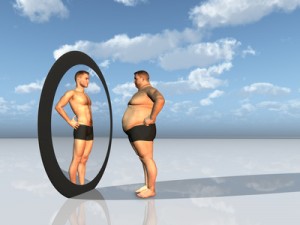
http://nickepedia.com/page/2/
“The law says that there is only one possible Barth in all the world. And you aren’t it. You’re just a number. And a letter. The letter H.”
― Orson Scott Card, Fat Farm
This week’s Neuroscience in Fiction pick is Fat Farm, by bestselling author of the Enderverse Orson Scott Card.
Martin Barth is a man with an insatiable appetite and a serious yo-yoing weight problem. Technology and wealth have helped him before, but in the end he must face the unforeseen consequences of his relentless pursuit of pleasure, youth and an ideal BMI.
Orson Scott Card said that he wrote Fat Farm in frustration with his own struggles with weight gain and loss. The story is part of the collection Maps in a Mirror, and a comic book version appears in Orson Scott Card’s InterGalactic Medicine Show.
Fat Farm touches upon multiple neuroscience themes, including the nature of self, consciousness, and perhaps most intriguingly, habit formation and maintenance.
For extra credit, check out our Fat Tuesday posts, where Steve and I discuss the neuroscience and psychology of hunger, satiety, weight gain and weight loss.
-Susana Martinez-Conde

http://www.annabellebreakey.com/quick-look/
You don’t get to be my size without eating a few large meals now and again. I’ve wondered if some of my darkest acts of eating might be considered binging. Apparently not, as the definition involves eating large amounts of food within a two-hour period at least twice per week: I’m more of a once-a-month overmuncher. But even then I feel fortunate that I have been compelled to eat the amounts that some guys do. Last Tuesday’s NY Times gave the example of a man who would eat 10,000-15,000 calories in a single 1.5-hour sitting, as reported on a study from the International Journal of Eating Disorders.
Binge eating combines cognitive dysfunction (we decide what to eat, we seek it out, acquire it, prepare it, and then eat it) with motivational dysfunction (the hunger itself is not a decision we make, and neither is the feeling of satiety that clearly fails to kick in during a binge). New research shows that binge eating is not more prevalent among females (as traditionally believed) but comparable across the sexes.
–Stephen Macknik
 Neurons are brain cells and they are similar to the other cells of the body in most every way, except that they reach for each other and pass little messages between themselves. It all happens through tiny connections, and the messages themselves are individually simple, but they are traded on such a massively numerous scale, that together they somehow create the very core of your being. These circuits are the Genesis of the syrupy flavor on your waffles. They are the chocolatey goodness of your, well, chocolate. And they motivate you to search for another mouthful.
Neurons are brain cells and they are similar to the other cells of the body in most every way, except that they reach for each other and pass little messages between themselves. It all happens through tiny connections, and the messages themselves are individually simple, but they are traded on such a massively numerous scale, that together they somehow create the very core of your being. These circuits are the Genesis of the syrupy flavor on your waffles. They are the chocolatey goodness of your, well, chocolate. And they motivate you to search for another mouthful.
How this all happens—the ingredients of this mental Chop Suey—are not well understood. But a new tour de force of a study in Nature by Deniz Atasoy and colleagues brings us a little closer to knowing the recipe.
The group based at Janelia Farms in Virginia analyzed the connectivity between neurons within the hypothalamus, specifically within the arcuate nucleus, which are activated in normal behavior by the feeding hormone ghrelin, evoke voracious binge eating when stimulated, and lead to starvation when they are killed. It’s pretty clear that they are critical to regulating feeding behavior. These cells are called AGRP neurons because they express a poorly understood gene called AGouti Related Protein. The brilliant strategy of the researchers was to reverse engineer the connectivity of the AGRP neurons in order to determine the underlying circuits that drive AGRPs to ring the dinner bell.
The surprising answer was that AGRP neurons evoke eating, at least in part, by suppressing oxytocin neurons in the nearby paraventricular hypothalamus. Oxytocin is known as the “love hormone”, and so the result brings a whole new meaning to the term “comfort food” since the results suggest that you can only feel truly touchy feely when your hunger is sated.
–Stephen Macknik

Barack Obama is sworn in as President
JAE C. HONG/AP
On Tuesdays, we discuss the neuroscience and psychology of hunger, satiety, weight gain and weight loss.
When did we start thinking of eating choices as moral choices? We say that a chocolate croissant is bad, and a raw carrot is good, but not only in terms of our health. We feel virtuous when we eat healthy foods in reasonable portion sizes and dissolute when we hit the drive thru or the vending machine. Time to stop the shame! New research suggests that we may be able to use the guilt trip to our dieting advantage. Behavioral economist Dan Ariely found that people lie and cheat less (for instance, in their tax returns) after they take a formal oath to be honest. Since succumbing to high-calorie, high-fructose corn-syrupy foods is considered “cheating”, maybe taking a solemn vow to eat healthily every morning, or even before each meal or snack, will help us to get slimmer?
I, Steve Macknik, swear on my honor to stick to my diet today. I vow to chew slowly and deliberately, putting my fork down between bites. I promise to make healthy food choices and to stop eating as soon as I have satisfied my hunger.
Before you conclude that this is preposterous, you should know that belief in the oath is not necessarily critical to its effectiveness. Ariely’s research showed that swearing on a bible deterred cheating even in atheists.
Would you make a “dieting oath” now? If so, come back here and let us know how that worked for you.
-Stephen Macknik



